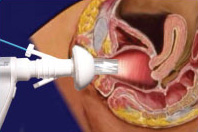Gynaecologists

|
|
| System | Female reproductive system |
|---|---|
| Subdivisions | Oncology, Maternal medicine, Maternal-fetal medicine |
| Significant diseases | Gynaecological cancers, Infertility |
| Significant tests | Laparoscopy |
| Specialist | Gynaecologist |
| Occupation | |
|---|---|
| Names | Doctor, Medical Specialist |
| Specialty | |
|
Activity sectors
|
Medicine |
| Description | |
|
Education required
|
|
|
Fields of
employment |
Hospitals, Clinics |
Gynaecology or gynecology (see spelling differences) is the medical practice dealing with the health of the female reproductive systems (vagina, uterus, and ovaries) and the breasts. Outside medicine, the term means "the science of women". Its counterpart is andrology, which deals with medical issues specific to the male reproductive system.
Almost all modern gynaecologists are also obstetricians (see obstetrics and gynaecology). In many areas, the specialities of gynaecology and obstetrics overlap.
The word "gynaecology" comes from the oblique stem (γυναικ-) of Greek γυνή (gyne), "woman", and -logia, "study".
The Kahun Gynaecological Papyrus is the oldest known medical text of any kind. Dated to about 1800 BC, it deals with women's complaints—gynaecological diseases, fertility, pregnancy, contraception, etc. The text is divided into thirty-four sections, each section dealing with a specific problem and containing diagnosis and treatment; no prognosis is suggested. Treatments are non surgical, comprising applying medicines to the affected body part or swallowing them. The womb is at times seen as the source of complaints manifesting themselves in other body parts.
The Hippocratic Corpus contains several gynaecological treatises dating to the 5th/4th centuries BC. Aristotle is another strong source for medical texts from 4th century BC with his descriptions of biology primarily found in History of Animals, Parts of Animals, Generation of Animals. The gynaecological treatise Gynaikeia by Soranus of Ephesus (1st/2nd century AD) is extant (together with a 6th-century Latin paraphrase by Muscio, a physician of the same school). He was the chief representative of the school of physicians known as the "Methodists".
...
Wikipedia
